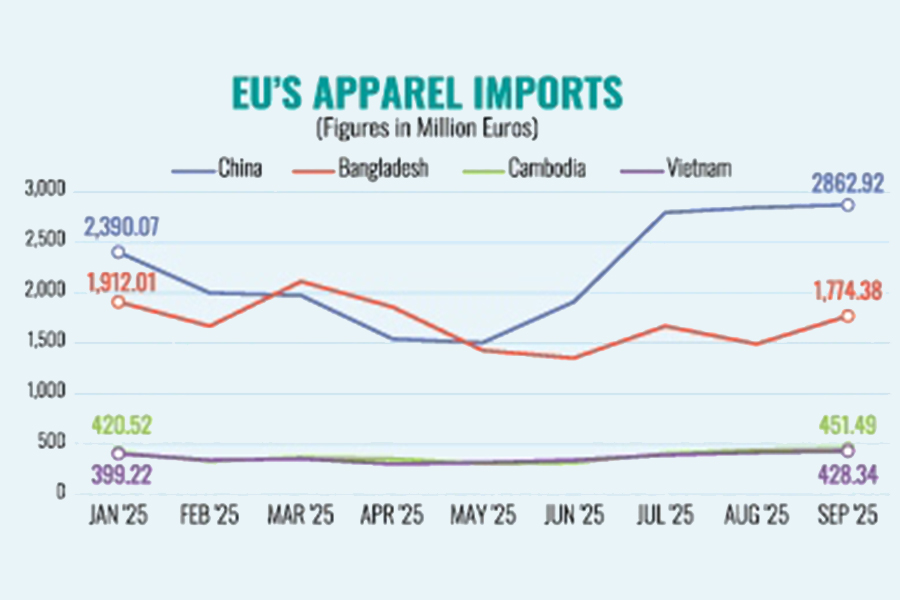Trade paradigm shift over US high-tariff regime
Bangladesh garment export to EU confronting crowding-out effect

Published :
Updated :

Bangladesh's garment export to the European Union faces crowding-out effect as major competitors, hitting US tariff walls, are making forays into the country's largest shipment destination, exporters say.
China, Vietnam, Cambodia and Pakistan have incrementally raised their concentration on the European Union (EU) market for a decade while they, mainly trade-major China, now intensify trade race as new US tariff regime comes into effect.
The ramped-up reciprocal tariffs force the players to diversify their shipment destinations to the 27-nation bloc in Europe.
Data analysis shows that China shipped garments, on average, worth of 1.87 billion euros each month from January to June of 2025 while the average shipments rose to 2.82 billion euros in July-September period of the current calendar year. The turnover takes China's overall garment shipments to the EU to 19.76 billion euros during the first nine months of 2025, according to Eurostat data.
On the other hand, Bangladesh's average single-month apparel-export earnings during the July-to-September period stood at 1.64 billion euros while the average monthly receipt was 1.71 billion euros during the first six months of 2025.
The country started 2025 with 1.91 billion euros in January, while the highest income worth of 2.11 billion euros was in March 2025. Export performance continued falling since April, save July and September, data analysis shows.
Apparel exports from the country fetched 15.25 billion euros, recording a 13.17-percent growth, during the last January-September period, in a rise from 13.47 billion euros in the corresponding period of 2024.
However, the single-month earnings missed the March mark.
Experts and exporters say constrained by American tariffs, supplies have been diverted to other key destinations, such as Japan, and Canada and mostly to the EU.
With Bangladesh holding over 20-percent share in the EU apparel market, this diversion could intensify price competition, squeezing margins and undermining profitability, they opine.
Asked about the latest trade situation, Fazlul Hoque, former president of Bangladesh Knitwear Manufacturers and Exporters Association (BKMEA), says data reflect Bangladesh's overall competitiveness gap with that of China.
"China's competitiveness is far better than that of Bangladesh with more efficient ports, no energy disruptions and uncertainty over political situation and national elections as here in the country while Bangladesh has low productivity, high lead time and cost of production," he explains.
"China, despite high wages there, is more competitive and able to instantly cope with the challenges, like as US tariff, with its high productivity, availability of raw materials like fabrics and no production disruption to diversify its destination, mostly to the EU," he told The Financial Express about the comparative advantages and disadvantages.
"Bangladesh can't compete only with cheap production-hub status."
Talking to the FE writer, Mohiuddin Rubel, a former director of Bangladesh Garment Manufacturers and Exporters Association (BGMEA), says though the average export growth of Bangladesh to the EU was good, the performances of other competitors, including China, Cambodia, Vietnam and Pakistan, were higher.
The last three moths' average shipment situation, especially after the new US tariff regime taking effect, has changed the overall market dimensions. On average, each month China shipped higher volumes of garments worth of 1.0 billion euros.
"In comparison, Bangladesh's average shipments during last three months since July rather decreased," he says, adding that competitors, mostly China, are entering the EU market aggressively by lowering prices significantly.
EU's apparel imports increased 7.14 per cent by value to 68.46 billion euros and 13.80 per cent by volume to 3.54 billion kilograms, showing a 5.86-percent decline in unit price during the January-to-September period of 2025 compared to that of 2024, statistics show.
Citing data, Mr Rubel says Indian apparel exports amounted to 3.76 billion euros during the first nine months of 2025, recording a 10.62-percent growth in value and 16.01-percent growth in volume, showing a 16.01-percent price fall.
Pakistan received 2.90 billion euros during the period, marking 13.77- percent rise in value, driven by 15.90-percent growth in volume and a 1.83-percent reduction in unit prices.
Cambodia posted particularly strong performance, with exports surging to 3.37 billion euros recording 22.51 per cent and 39.65 per cent growth in value and volume respectively.
Unit prices for Cambodia-made garments fell by 12.27 per cent, reflecting an assertive strategic shift towards the EU amid weaker conditions on the US market, he notes.
Unit price of Vietnamese garments, however, witnessed a 2.65-percent rise, he says, attributing their high value-added items.
"While these countries achieved robust volume and value growth, the broad-based decline in average prices highlights the intense competitive pressure within the EU apparel market as well as buyers' focus on cost containment in an inflationary environment," Mr Rubel, also additional managing director of Denim Expert Ltd, notes.
munni_fe@yahoo.com


 For all latest news, follow The Financial Express Google News channel.
For all latest news, follow The Financial Express Google News channel.